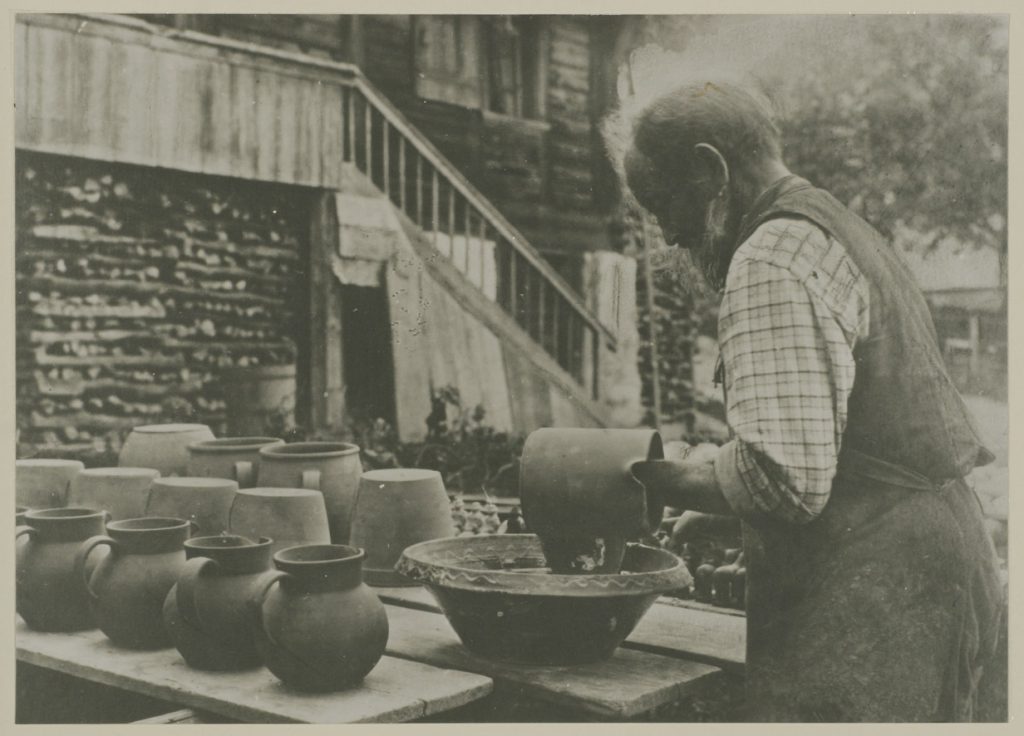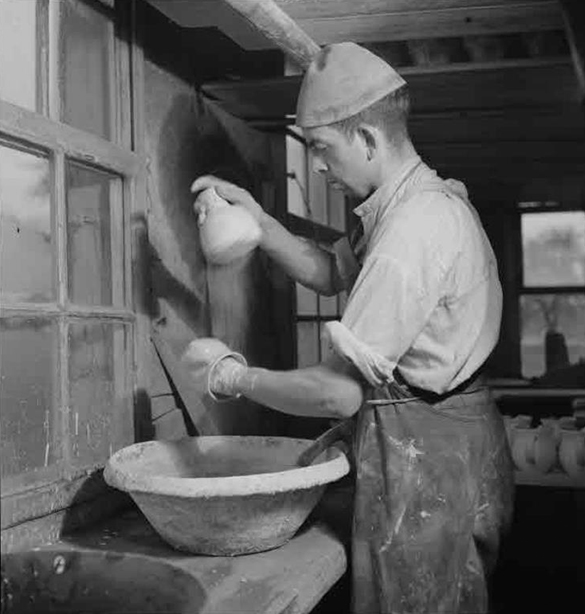
Wet glaze: Dipping the leather-hard vessel into a suspension of glaze and water or pouring the suspension onto the vessel using a glaze ladle. It appears that many of the potters’ workshops in the Canton of Bern began to use this technique in the second half of the 19th century, first in Langnau and later in the region around Heimberg-Steffisburg (Merz 1874; Schwab 1921; Heege/Kistler 2019, 223). Before that, dry glazing was the method of choice everywhere.

Applying finely ground glaze or lead oxide (so-called dry glazing). Hänni pottery, Heimberg 1946 (StAB FN_Hesse_249).
Dry glaze: Glazing bone-dry pottery is difficult because the clay expands as soon as it becomes wet, which can lead to the object cracking or losing its shape. That is why in many regions of Switzerland “dry glazing” was used. The technique was first described in 1836 by Alexandre Brongniart, the Director of the Sèvres factory, and termed “saupoudration” (the modern term is “saupoudrage”) or “aspersion” (Brongniart 1844, 15 and 179). The method itself, however, has been used since classical Antiquity. It involved covering the vessel with a thin paste of flour or potato starch and water or a liquid suspension of glaze in a starch and water mixture and adding dry, finely ground lead oxide or lead glaze using a pouncer. The result was a thicker coat of glaze as some of the water in the suspension was absorbed by the clay. Heimberg potters were convinced that this technique produced thicker and shinier glazes (Merz 1874, 30). One of the dangers of using this method was that potters were exposed to lead by inhaling the powdered glaze, which over time caused them to develop lead poisoning. The technique was used by potters in the region around Heimberg-Steffisburg until the 1880s. It was also known in Sweden (Walerius 1973, 97-98) and in Staffordshire prior to 1740, but there it was soon replaced by dipping the vessels in a liquid glaze (Towner 1978, 20; Reilly 1995, 202).
Translation Sandy Haemmerle
References:
Brongniart 1844
Alexandre Brongniart, Traité des arts céramiques ou des poteries considérées dans leur histoire, leur pratique et leur théorie, Paris 1844.
Frei 1932
Karl Frei, Bemalte Steckborner Keramik des 18. Jahrhunderts (Mitteilungen der antiquarischen Gesellschaft in Zürich 31), Zürich 1932, bes. 22.
Merz 1874
Joseph Merz, Die Industrien im Berneroberland, deren Hebung und Vermehrung: Vortrag an der Hauptversammlung des gemeinnützigen Vereins des Kantons Bern, den 19. Oktober 1873 in Thun, Bern 1874.
Reilly 1995
Robin Reilly, Wedgwood: The new illustrated dictionary, Woodbridge 1995.
Schwab 1921
Fernand Schwab, Beitrag zur Geschichte der bernischen Geschirrindustrie (Schweizer Industrie- und Handelsstudien 7), Weinfelden/Konstanz 1921.
Towner 1978
Donald C. Towner, Creamware, London 1978.
Walerius 1973
Ernst Walerius, Pottemakare, krukmakare, kakelugnsmakare i Falkenberg (Skrifter fran Folklivsakivet i Lund 14), Lund 1973.

